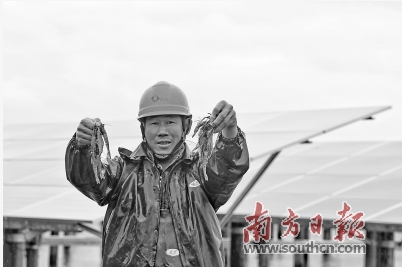
Surprisingly, this fish pond is somewhat different, which is covered by a vast array of photovoltaic panels. "Solar panels work to produce electricity above water while aquaculture takes place underwater. In this way, we can make full use of fish ponds, improve land use efficiency, and develop a demonstration project that combines aquaculture and photovoltaics." Li Yahong, general manager of a branch of GCL New Energy in Guangdong told the reporter. The manager also noted that in March 2017, they began work on a 30MW floating solar power farm, which entailed a land of about 423,333 m². The project had received an investment of 240 million and set out to supply electricity when it was completed and connected to power grids at the end of June the same year. It was anticipated to generate an annual income of about 34 million yuan and a total tax contribution of more than 6 million yuan.
Guided by the mode of "floating solar complementing aquaculture", in August 2017, Ni Qirong cooperated with project contractors to carry out a series of experiments on aquaculture, primarily on bearding shrimps and prawns mixed with grass carp, silver carp, crucian carp and other fishes. The experimental area covered about 33,333 m². "A few years ago, without solar panels on the water, there are numerous water lettuces and plankton floating on the surface of the fish ponds every summer. Now, since we have exploited the effect of shading on solar panels, the temperature of the water can be controlled within a desirable range. What's more, there are no water lettuces any more, thus shrimps and fishes won't be suffocated to death underwater due to high temperature." he explained.
Speaking of gains, Mr. Ni had done his accounts: there was roughly a yield of 200 kg of shrimps and 400 kg of fishes per mu*, whose production value is about 20,000 yuan. Hence with total 50 mu, he could get a total production value of 1 million yuan, earning a net income of more than 300,000 yuan. Mr. Ni said that he would soon make specific plans to expand the scale of breeding.
Li Yahong said, "Farmers make profits through land lease. Our company focuses on developing photovoltaics while farmers can continue to breed shrimps and fishes. At the same time, it will also help to increase tax revenues for local government. In this way, we get three great things done just at one stroke and promote the common development of rural areas, agriculture, farmers and enterprises." She also added that they planned to work on another 20MW floating solar power plant, which would cover 324,666 m². The project, which had received an investment of 160 million, was scheduled to start at the beginning of March, 2018 and be completed and connected to power grids at the end of June. The farm was anticipated to supply over 100,000 kilowatt-hours of electricity per day, generate an annual income of about 25 million yuan and a total tax contribution of more than 4 million yuan.
The report delivered at the 19th National Congress of the Communist Party of China underscored making strong moves in the rural revitalization strategy and encouraging the primary, secondary, and tertiary industries to develop in an integrated way in rural areas. Floating photovoltaic agriculture is a new way of developing agriculture and enriching farmers through science and technology. Furthermore, solar photovoltaics being neatly arranged on an endless water surface is a unique view, and it will become a local tourist attraction which can create considerable tourism benefits. In this way, we can truly promote the cooperative development of the primary, secondary, and tertiary industries. In the near future, it is advisable to build greenways around floating photovoltaic agriculture connecting to surrounding lakes, wetlands, bird sanctuaries, hot springs and other tourism resources, which will definitely boost the development of rural tourism. (Editor: Claire Jeawin)
*Note: 1 mu roughly equals to 666 m².